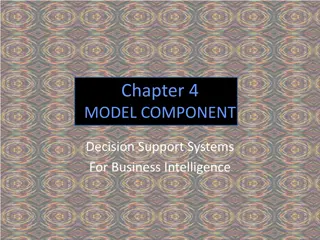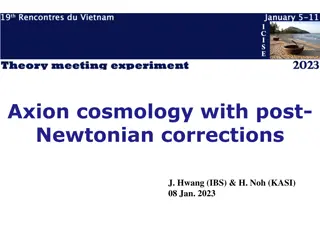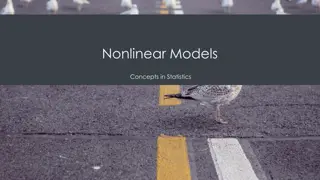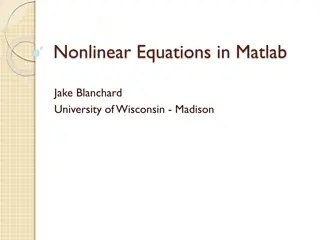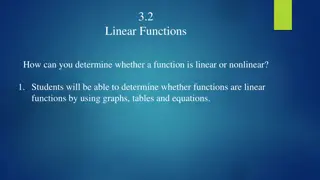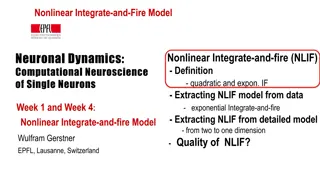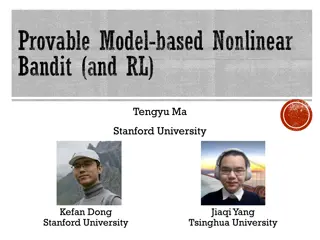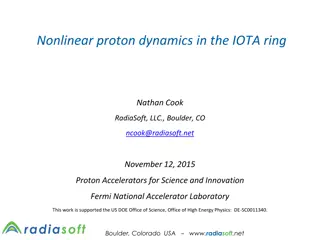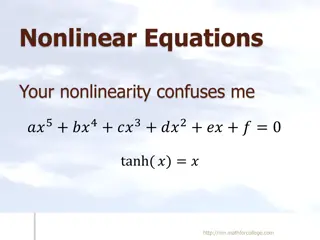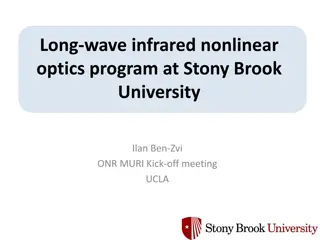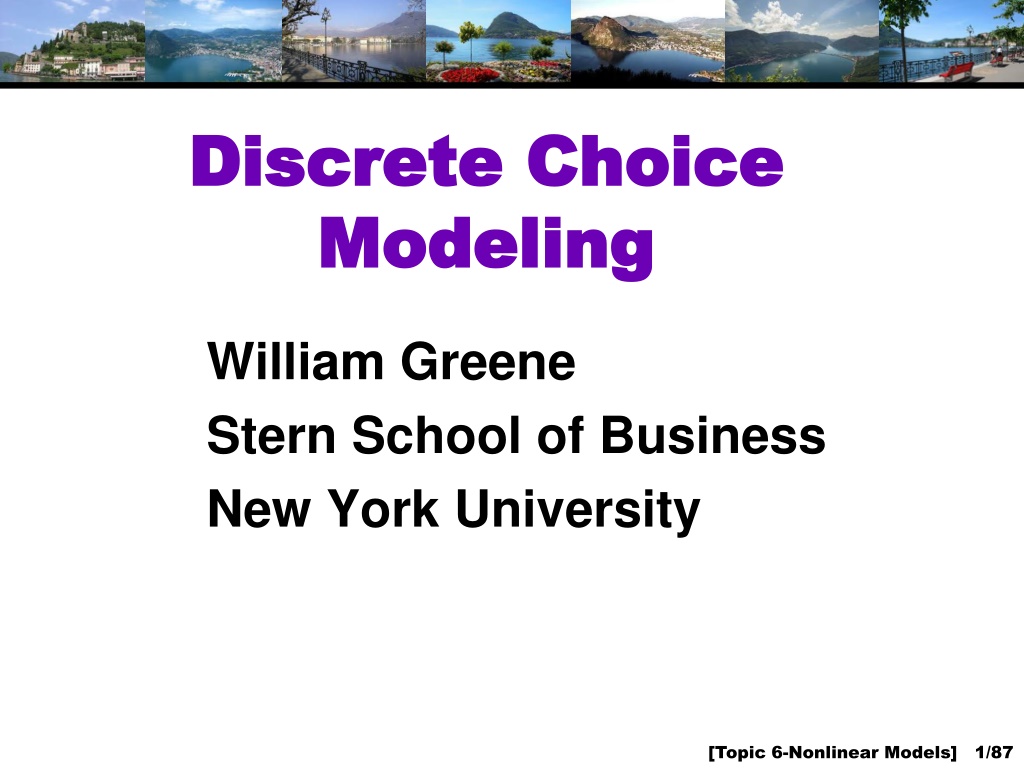
Nonlinear Models in Discrete Choice Modeling
Explore the world of nonlinear models in discrete choice modeling with a focus on estimation theory, model characteristics, and parameter spaces. Dive into topics such as unconditional and conditional moments, fully parametric specifications, and different types of estimators like maximum likelihood.
Download Presentation

Please find below an Image/Link to download the presentation.
The content on the website is provided AS IS for your information and personal use only. It may not be sold, licensed, or shared on other websites without obtaining consent from the author. If you encounter any issues during the download, it is possible that the publisher has removed the file from their server.
You are allowed to download the files provided on this website for personal or commercial use, subject to the condition that they are used lawfully. All files are the property of their respective owners.
The content on the website is provided AS IS for your information and personal use only. It may not be sold, licensed, or shared on other websites without obtaining consent from the author.
E N D
Presentation Transcript
Discrete Choice Discrete Choice Modeling Modeling William Greene Stern School of Business New York University [Topic 6-Nonlinear Models] 1/87
6. NONLINEAR MODELS 6. NONLINEAR MODELS [Topic 6-Nonlinear Models] 2/87
Agenda Nonlinear Models Estimation Theory for Nonlinear Models Estimators Properties M Estimation Nonlinear Least Squares Maximum Likelihood Estimation GMM Estimation Minimum Distance Estimation Minimum Chi-square Estimation Computation Nonlinear Optimization Nonlinear Least Squares Newton-like Algorithms; Gradient Methods (Background: JW, Chapters 12-14, Greene, Chapters 7,12-14) [Topic 6-Nonlinear Models] 3/87
What is the Model? What is the Model? Unconditional characteristics of a population Conditional moments: E[g(y)|x]: median, mean, variance, quantile, correlations, probabilities Conditional probabilities and densities Conditional means and regressions Fully parametric and semiparametric specifications Parametric specification: Known up to parameter Conditional means: E[y|x] = m(x, ) [Topic 6-Nonlinear Models] 4/87
What is a What is a Nonlinear Nonlinear Model? Model? Model: E[g(y)|x] = m(x, ) Objective: Learn about from y, X Usually estimate Linear Model: Closed form; = h(y, X) Nonlinear Model Not necessarily wrt m(x, ). E.g., y = exp( x + ) Wrt estimator: Implicitly defined. h(y, X, )=0, E.g., E[y|x]= exp( x) [Topic 6-Nonlinear Models] 5/87
What is an Estimator? What is an Estimator? Point and Interval f(data|model) I( ) sampling variability = = Classical and Bayesian = = E[ |data,prior f( )] I( ) narrowest interval from posterior density containing the specified probability (mass) expectation from posterior = [Topic 6-Nonlinear Models] 6/87
Parameters Parameters Model parameters The parameter space: Estimators of parameters The true parameter(s) exp( y / ) x = = Example: f(y | x ) , exp( x ) i i i i i i i Model parameters : Conditional Mean: E(y | = = ) exp( x ) i i i i [Topic 6-Nonlinear Models] 7/87
The Conditional Mean Function The Conditional Mean Function = m( , A property of the conditional mean: E (y m( , )) is minimized by E[y| ] (Proof, pp. 343-344, JW) x ) E[y| ] for some x in . 0 0 2 x x y,x [Topic 6-Nonlinear Models] 8/87
M Estimation M Estimation Classical estimation method 1 n n = , ) arg min q( data i i=1 Example:Nonlinear Least squares 1 arg min n n 2 = , )] [y -E(y | x i i i i=1 [Topic 6-Nonlinear Models] 9/87
An Analogy Principle for M Estimation An Analogy Principle for M Estimation 1 n n The estimator minimizes q= q(data , ) i i 1 = The true parameter minimizes q*=E[q(data, )] 0 The weak law of large numbers: 1 n n P q= q(data , ) q*=E[q(data, )] i i 1 = [Topic 6-Nonlinear Models] 10/87
Estimation Estimation 1 n n P q= q(data , ) q*=E[q(data, )] i i 1 = Estimator minimizes q True parameter q q* Does this imply Yes, if ... minimizes q* 0 P P ? 0 [Topic 6-Nonlinear Models] 11/87
Identification Identification Uniqueness : If 1 Examples in which this property is not met: (1) (Multicollinearity) (2) (Need for normalization) E[y|x] = m( x/ ) (3) (Indeterminacy) m(x, )= , then m(x, ) m(x, ) for some x 0 1 0 x when + 1 + = 3 x 0 4 2 3 [Topic 6-Nonlinear Models] 12/87
Continuity Continuity q(data , ) is (a) Continuous in for all data and all (b) Continuously differentiable. First derivatives are also continuous (c) Twice differentiable. Second derivatives must be nonzero, thoug be continuous functions of . (E.g. Linear LS) i i h they need not [Topic 6-Nonlinear Models] 13/87
Consistency Consistency 1 n n P q= q(data , ) q*=E[q(data, )] i i 1 = Estimator minimizes q True parameter q q* Does this imply Yes. Consistency follows from identification and continuity with the other a minimizes q* 0 P P ? 0 ssumptions [Topic 6-Nonlinear Models] 14/87
Asymptotic Normality of M Asymptotic Normality of M Estimators Estimators First order conditions: (1/n) q(data , ) q(data , ) 1 n 1 (data , ) n For any , this is the mean of a random sample. We apply Lindberg-Feller CLT to assert N i=1 = 0 i N i=1 = i = N i=1 = g (data, ) g i the limit ing normal distribution of n (data, ). g [Topic 6-Nonlinear Models] 15/87
Asymptotic Normality Asymptotic Normality A Taylor series expansion of the derivative (data, ) (data, q(data , ) 1 ( ) n = some point between and Then, ( ) [ ( )] n ( ) [ ( )] = H n (data, = + ( )( H = g g ) ) 0 0 0 2 n i 1 = = H i 0 1 = H (data, g ) and 0 0 1 g ) 0 0 [Topic 6-Nonlinear Models] 16/87
Asymptotic Normality Asymptotic Normality 1 = [ ( )] n (data, H n ( H ) g ) 0 0 1 [ ( )] converges to its expectation (a matrix) g n (data, vector (Lindberg-Feller) ) converges to a normally distributed 0 Implies limiting normal distribution of n ( Limiting mean is 0. Limiting variance to be obtained. Asymptotic distribution obtained by the usual means. 0). [Topic 6-Nonlinear Models] 17/87
Asymptotic Variance Asymptotic Variance + Asymptotically normal Mean Asy.Var[ ] (A sandwich estimator, as usual) What is Var[ (data, 1E[ (data , ) (data , n Not known n n a 1 [ ( )] (data, H g ) 0 0 = 0 1 1 = [ ( H )] Var[ (data, g )] [ ( H )] 0 0 0 g )]? 0 g g )'] i 0 i 0 what it is, but it is easy to estimate. 1 1 n (data , ) (data , )' g g = i 1 i i [Topic 6-Nonlinear Models] 18/87
Estimating the Variance Estimating the Variance = 1 1 Asy.Var[ ] [ ( H )] Var[ (data, g )] [ ( H )] 0 0 0 2 m(data , ) 1 n n 1 Estimate [ ( H )] with i 0 = i 1 m(data , ) m(data , ) 1 1 n n n Estimate Var[ (data, g )] with i i 0 = i 1 i n i=1 2 E.g., if this is linear least squares, (1/2) (y -x ) i = i 2 m(data , ) (1 / 2)(y xb) i i 2 m(data , ) 1 n n 1 = ( X X /n) i = i 1 m(data , ) m(data , ) 1 1 n n n i 2 N 2 i = (1 / n ) e x x i i = i 1 i = i 1 [Topic 6-Nonlinear Models] 19/87
Nonlinear Least Squares Nonlinear Least Squares Gauss-Marquardt Algorithm q the conditional mean function = m( , ) m( , ) g x = i x i x 0 i = = = 'pseudo regressors' i i Algorithm - iteration (k+1) (k) 0 0 1 0 0 = + [ X 'X ] X 'e [Topic 6-Nonlinear Models] 20/87
Application Application - - Income Income German Health Care Usage Data, 7,293 Individuals, Varying Numbers of Periods Variables in the file are Data downloaded from Journal of Applied Econometrics Archive. This is an unbalanced panel with 7,293 individuals. They can be used for regression, count models, binary choice, ordered choice, and bivariate binary choice. This is a large data set. There are altogether 27,326 observations. The number of observations ranges from 1 to 7. (Frequencies are: 1=1525, 2=2158, 3=825, 4=926, 5=1051, 6=1000, 7=987). Note, the variable NUMOBS below tells how many observations there are for each person. This variable is repeated in each row of the data for the person. (Downloaded from the JAE Archive) HHNINC = household nominal monthly net income in German marks / 10000. (4 observations with income=0 were dropped) HHKIDS = children under age 16 in the household = 1; otherwise = 0 EDUC = years of schooling AGE = age in years [Topic 6-Nonlinear Models] 21/87
Income Data Income Data 2.74 2.19 1.64 Density 1.09 .55 .00 .00 1.00 2.00 3.00 4.00 5.00 INCOME Kernel density estimate for INCOME [Topic 6-Nonlinear Models] 22/87
Exponential Model Exponential Model f(Income| Age,Educ,Married) HHNINC 1exp = = + + i i i + exp(a a Educ a Married a Age) = i 0 1 2 3 E[HHNINC| Age,Educ,Married] Starting values for the iterations: E[y |nothing else]=exp(a ) i i 0 = = = Start a = logHHNINC, a a 3a 0 0 1 2 [Topic 6-Nonlinear Models] 23/87
Conventional Variance Estimator Conventional Variance Estimator i n i 1 = 2 [y #parameters m(x , )]( 0 0 1 X X ) i n Sometimes omitted. [Topic 6-Nonlinear Models] 24/87
Estimator for the M Estimator Estimator for the M Estimator i 2 2 = = = y = q g H (1 / 2)[y e x x exp( x )] (1 / 2)(y ) i i i i i x i i i i i i i i i N i=1 N i=1 -1 N i=1 N i=1 e -1 te estimator. See JW, p. 359. x x Estimator is [ = [ This is the Whi H ] [ y gg ][ H ] i i i 2 i i i i -1 N i=1 2 i N i=1 -1 ] [ x x ][ y x x ] i i i i i i i [Topic 6-Nonlinear Models] 25/87
Computing NLS Computing NLS Reject; hhninc=0$ Calc ; b0=log(xbr(hhninc))$ Names ; x=one,educ,married,age$ Nlsq ; labels=a0,a1,a2,a3 ; start=b0,0,0,0 ; fcn=exp(a0 x) ; lhs=hhninc;output=3$ Create; thetai = exp(x'b) ; ei=hhninc-thetai ; gi2=(ei*thetai)^2 ; hi=hhninc*thetai$ Matrix; varM = <x'[hi] x> * x'[gi2]x * <x'[hi] x> $ Matrix; stat(b,varM,x)$ [Topic 6-Nonlinear Models] 26/87
Iterations Convergence Iterations Convergence 0 0 0 0 -1 0 0 = 'gradient' e X ( X ' X ) X ' e Begin NLSQ iterations. Linearized regression. Iteration= 1; Sum of squares= 854.681775 ; Gradient= 90.0964694 Iteration= 2; Sum of squares= 766.073500 ; Gradient= 2.38006397 Iteration= 3; Sum of squares= 763.757721 ; Gradient= .300030163E-02 Iteration= 4; Sum of squares= 763.755005 ; Gradient= .307466962E-04 Iteration= 5; Sum of squares= 763.754978 ; Gradient= .365064970E-06 Iteration= 6; Sum of squares= 763.754978 ; Gradient= .433325697E-08 Iteration= 7; Sum of squares= 763.754978 ; Gradient= .514374906E-10 Iteration= 8; Sum of squares= 763.754978 ; Gradient= .610586853E-12 Iteration= 9; Sum of squares= 763.754978 ; Gradient= .724960231E-14 Iteration= 10; Sum of squares= 763.754978 ; Gradient= .860927011E-16 Iteration= 11; Sum of squares= 763.754978 ; Gradient= .102139114E-17 Iteration= 12; Sum of squares= 763.754978 ; Gradient= .118640949E-19 Iteration= 13; Sum of squares= 763.754978 ; Gradient= .125019054E-21 Convergence achieved [Topic 6-Nonlinear Models] 27/87
NLS Estimates NLS Estimates +----------------------------------------------------+ | User Defined Optimization | | Nonlinear least squares regression | | LHS=HHNINC Mean = .3521352 | | Standard deviation = .1768699 | | Residuals Sum of squares = 763.7550 | +----------------------------------------------------+ +---------+--------------+----------------+--------+---------+ |Variable | Coefficient | Standard Error |b/St.Er.|P[|Z|>z] | +---------+--------------+----------------+--------+---------+ Conventional Estimates Constant -1.89118955 .01879455 -100.624 .0000 EDUC .05471841 .00102649 53.306 .0000 MARRIED .23756387 .00765477 31.035 .0000 AGE .00081033 .00026344 3.076 .0021 +---------+--------------+----------------+--------+---------+ Recomputed variances using sandwich estimator for M Estimation. B_1 -1.89118955 .01910054 -99.012 .0000 B_2 .05471841 .00115059 47.557 .0000 B_3 .23756387 .00842712 28.190 .0000 B_4 .00081033 .00026137 3.100 .0019 [Topic 6-Nonlinear Models] 28/87
Hypothesis Tests for M Estimation Hypothesis Tests for M Estimation Null hypothesis: ( )= for some set of J functions (1) continuous ( ) (2) differentiable; = c 0 c ( ), J K Jacobian R (3) functionally independent: Rank ( ) = J Wald: given , =Est.Asy.Var[ ], W=Wald d istance =[ ( )- ( )] { ( ) ( ) ( ) } [ ( )- ( )] chi-squared[J] R V -1 c c R V R ' c c [Topic 6-Nonlinear Models] 29/87
Change in the Criterion Function Change in the Criterion Function 1 n n P q= q(data , ) q*=E[q(data, )] i = i 1 Estimator minimizes q Estimator restrictions ( )=0 q q. c minimizes q subject to c c D c 2n(q q ) chi squared[J] [Topic 6-Nonlinear Models] 30/87
Score Test Score Test LM Statistic Derivative of the objective function (1 /n) Score vector = n i=1 q(data , ) = (data, ) g i = Without restrictions (data, ) With null hypothesis, ( ) imposed (data, ) generally not equal to g (Within sampling variability?) Wald distance = [ (data, LM chi squared[J] g 0 c c 0 . Is it close? c c 1 c g )] {Var[ (data, ' g )]} [ (data, g )] D [Topic 6-Nonlinear Models] 31/87
Exponential Model Exponential Model f(Income| Age,Educ,Married) HHNINC 1exp = = + = + i i i + exp(a a Educ a = a Married 0 = a Age) i 0 1 2 3 Test H : a a 0 1 2 3 [Topic 6-Nonlinear Models] 32/87
Wald Test Wald Test Matrix ; List ; R=[0,1,0,0 / 0,0,1,0 / 0,0,0,1] ; c=R*b ; Vc = R*Varb*R' ; Wald = c'<VC>c $ Matrix R has 3 rows and 4 columns. .0000000D+00 1.00000 .0000000D+00 .0000000D+00 .0000000D+00 .0000000D+00 1.00000 .0000000D+00 .0000000D+00 .0000000D+00 .0000000D+00 1.00000 Matrix C has 3 rows and 1 columns. .05472 .23756 .00081 Matrix VC has 3 rows and 3 columns. .1053686D-05 .4530603D-06 .3649631D-07 .4530603D-06 .5859546D-04 -.3565863D-06 .3649631D-07 -.3565863D-06 .6940296D-07 Matrix WALD has 1 rows and 1 columns. 3627.17514 [Topic 6-Nonlinear Models] 33/87
Change in Function Change in Function Calc ; M = sumsqdev $ (from unrestricted) Calc ; b0 = log(xbr(hhninc)) $ Nlsq ; labels=a0,a1,a2,a3;start=b0,0,0,0 ; fcn=exp(a0+a1*educ+a2*married+a3*age) ; fix=a1,a2,a3 ? Fixes at start values ; lhs=hhninc $ Calc ; M0 = sumsqdev $ [Topic 6-Nonlinear Models] 34/87
Constrained Estimation Constrained Estimation Nonlinear Estimation of Model Parameters Method=BFGS ; Maximum iterations=100 Start values: -.10437D+01 1st derivs. -.26609D-10 Parameters: -.10437D+01 Itr 1 F= .4273D+03 gtHg= .2661D-10 * Converged NOTE: Convergence in initial iterations is rarely at a true function optimum. This may not be a solution (especially if initial iterations stopped). Exit from iterative procedure. 1 iterations completed. Why did this occur? The starting value is the minimizer of the constrained function [Topic 6-Nonlinear Models] 35/87
Constrained Estimates Constrained Estimates +----------------------------------------------------+ | User Defined Optimization | | Nonlinear least squares regression | | LHS=HHNINC Mean = .3521352 | | Standard deviation = .1768699 | | Residuals Sum of squares = 854.6818 | +----------------------------------------------------+ +---------+--------------+----------------+--------+---------+ |Variable | Coefficient | Standard Error |b/St.Er.|P[|Z|>z] | +---------+--------------+----------------+--------+---------+ A0 -1.04374019 .00303865 -343.488 .0000 A1 .000000 ......(Fixed Parameter)....... A2 .000000 ......(Fixed Parameter)....... A3 .000000 ......(Fixed Parameter)....... --> calc ; m0=sumsqdev ; list ; df = 2*(m0 - m) $ DF = 181.854 [Topic 6-Nonlinear Models] 36/87
LM Test LM Test 2 = + Function: q Derivative: LM statistic (1/2)[y e = exp(a a Educ...)] i i 0 1 g x i i i i n i 1 = n i 1 = 1 n i 1 = LM=( All evaluated at a g )[ gg ] ( = g ) i i i i log(y),0,0,0 0 [Topic 6-Nonlinear Models] 37/87
LM Test Name ;x=one,educ,married,age$ Create ;thetai=exp(x'b);ei=hhninc-thetai$ Create ;gi=ei*thetai ; gi2 = gi*gi $ Matrix ; list ; LM = 1'[gi]x * <x'[gi2]x> * x'[gi]1 $ Matrix LM has 1 rows and 1 columns. 1 +-------------- 1| 1915.03286 [Topic 6-Nonlinear Models] 38/87
Maximum Likelihood Estimation Maximum Likelihood Estimation Fully parametric estimation Density of yi is fully specified The likelihood function = the joint density of the observed random variable. Example: density for the exponential model y 1 f(y | ) exp = x x i = x , exp( x ) i i i i i i 2 i E[y | NLS (M) estimator examined earlier operated only on E[y | ]= , Var[y | ]= i i i i i x ]= . i i i [Topic 6-Nonlinear Models] 39/87
The Likelihood Function The Likelihood Function y 1 i = = i f(y | x ) exp , exp( x ) i i i = i i Likelihood By independence, f(y ,...,y | x ,..., x ) 1 n 1 n y 1 n i = i L( |data )= exp , exp( x ) i i=1 i i The MLE , , maximizes the likelihood function MLE [Topic 6-Nonlinear Models] 40/87
Log Likelihood Function Log Likelihood Function y 1 i = = i f(y | x ) exp , exp( x ) i i i i i y 1 n i = i L( |data )= exp , exp( x ) i i=1 i i The MLE , logL( |data , maximizes the likelihood function ) is a monotonic function. Therefore MLE The MLE , , ma ximizes the log likelihood function y -log MLE n logL( |data )= i i i=1 i [Topic 6-Nonlinear Models] 41/87
Conditional and Unconditional Likelihood Conditional and Unconditional Likelihood Unconditional joint density f(y , our parameters of interest = parameters of the marginal density of Unconditional likelihood function x |x | , ) x i i = x i n L( , |y, )= | , ) X f(y , x i i i=1 f(y | , ) = | , ) f(y , , , )g ( x i i i i i n L( , |y, )= , , )g( | , ) X f(y |x x i i i i=1 Assuming the parameter space partitions n n logL( , |y, )= = , ) + | ) X logf(y |x logg( x i i i i=1 i=1 conditional log likelihood + marginal log likelihood [Topic 6-Nonlinear Models] 42/87
Concentrated Log Likelihood Concentrated Log Likelihood Consider a partition, =( , ) two parts. maximizes logL( |data) MLE logL = Maximum occurs where 0 Joint solution equates both derivatives to 0. If logL/ =0 admits an implicit solution for in = c logL ( , ( ))=a function only of . Concentrated log likelihood can be maximized for , then the solution computed for . The solution must occur where the search to this subspace of the parameter space. terms of , ( ), then write MLE = ( ) ,so restrict MLE [Topic 6-Nonlinear Models] 43/87
A Concentrated Log Likelihood A Concentrated Log Likelihood Fixed effects exponential regression: it = it + i exp( x ) n T = it logL ( log y / ) it it = i 1 n = t 1 T it it = + ( ( x ) y exp( x )) i it i = i 1 = t 1 logL T it = 1 y exp( x )( 1) it i = t 1 i exp( T i = + t T y exp( x ) it i = t 1 T it = + = T ) y exp( x ) 0 i it = t 1 it T t 1 y / exp(x T ) = it = i = ( ) Solve this for log i it T t 1 y / exp(x T ) it c = it Concentrated log likelihood has exp(x ) = it [Topic 6-Nonlinear Models] 44/87
ML and M Estimation ML and M Estimation n = logL( ) logf(y | x , ) i i i 1 = n MLE = argmax logf(y | x , ) i i = i 1 1 n n = argmin - logf(y | x , ) i i i 1 = The MLE is an M estimator. We can use all of the previous results for M estimation. [Topic 6-Nonlinear Models] 45/87
Regularity Conditions Regularity Conditions Conditions for the MLE to be consistent, etc. Augment the continuity and identification conditions for M estimation Regularity: Three times continuous differentiability of the log density Finite third moments of log density Conditions needed to obtain expected values of derivatives of log density are met. (See Greene (Chapter 14)) [Topic 6-Nonlinear Models] 46/87
Consistency and Asymptotic Consistency and Asymptotic Normality of the MLE Normality of the MLE Conditions are identical to those for M estimation Terms in proofs are log density and its derivatives Nothing new is needed. Law of large numbers Lindberg-Feller central limit applies to derivatives of the log likelihood. [Topic 6-Nonlinear Models] 47/87
Asymptotic Variance of the MLE Asymptotic Variance of the MLE Based on results for M estimation Asy.Var[ ] ={-E[Hessian]} {Var[first derivative]}{-E[Hessian]} MLE -1 -1 1 1 2 2 logL logL logL = -E Var -E [Topic 6-Nonlinear Models] 48/87
The Information Matrix Equality The Information Matrix Equality Fundamental Result for MLE The variance of the first derivative equals the negative of the expected second derivative. logL -E The Information Matrix = 2 MLE Asy.Var[ ] 1 1 2 2 2 logL logL logL = -E -E -E 1 2 logL = -E [Topic 6-Nonlinear Models] 49/87
Three Variance Estimators Three Variance Estimators Negative inverse of expected second derivatives matrix. (Usually not known) Negative inverse of actual second derivatives matrix. Inverse of variance of first derivatives [Topic 6-Nonlinear Models] 50/87

